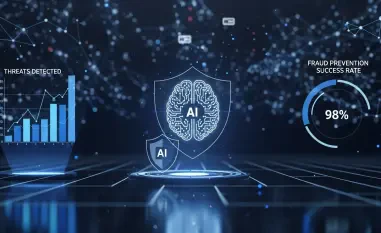In today’s digital age, cybersecurity is a critical concern for organizations of all sizes. With the increasing frequency and sophistication of cyber threats, traditional security measures are no longer sufficient. This has led to a growing reliance on AI-powered cybersecurity solutions, which offer advanced threat detection and proactive security measures. Many organizations are now finding that these AI technologies can significantly transform their return on investment (ROI). However, understanding how these technologies impact the bottom line involves examining several key aspects, including financial benefits, challenges, and specific metrics associated with their implementation.
The Rising Investment in AI-Powered Cybersecurity
Organizations are investing heavily in AI-powered cybersecurity solutions. In 2023, global spending on these technologies reached $24 billion, projected to soar to $133 billion by 2030. This surge in investment is driven by escalating costs of data breaches and the need for more robust security measures. AI technologies offer the promise of enhanced threat detection, faster response times, and reduced operational costs, making them an attractive option for businesses looking to safeguard their digital assets. This dramatic increase in spending is not just a trend; it’s a necessity driven by the rapidly evolving cyber threat landscape.
The increasing reliance on AI in cybersecurity is vital. As cyber threats become more sophisticated, traditional security measures struggle to keep pace. AI-powered solutions can analyze vast amounts of data in real-time, identifying patterns and anomalies indicative of potential threats. This proactive approach allows organizations to address vulnerabilities before they can be exploited, significantly reducing the risk of costly data breaches. Implementing such technologies ensures that companies stay ahead of potential attacks, protecting their sensitive data and maintaining the integrity of their operations.
Challenges in Measuring Cybersecurity ROI
One of the primary challenges in implementing AI-powered cybersecurity solutions is measuring their ROI. Traditional methods of calculating ROI in cybersecurity often focus predominantly on money saved in the absence of incidents. However, this approach fails to capture the full value of AI technologies, which offer proactive security measures, efficiency improvements, and enhanced threat detection capabilities. The intangible benefits provided by these technologies are crucial, yet often overlooked when calculating ROI in the conventional sense.
Measuring the value of data not stolen, reputational damage that didn’t occur or customer trust maintained can be difficult. These intangible benefits are critical for understanding the true impact of AI-powered cybersecurity solutions. Organizations need to adopt new metrics and frameworks to accurately assess the ROI of these advanced technologies. Instead of relying solely on traditional measures of cost avoidance, businesses must consider factors such as efficiency gains, improved threat intelligence accuracy, and the overall organizational resilience provided by AI-driven security measures.
Quantifiable Metrics with AI Integration
Despite the challenges, several quantifiable metrics can help organizations measure the ROI of AI-powered cybersecurity solutions. One key metric is the reduction in false positives. AI systems can significantly reduce erroneous alerts, allowing security teams to focus on genuine threats. This improvement not only enhances the efficiency of security operations but also reduces the risk of missing critical threats amidst a sea of false alarms. Reduced false positives lead to a more effective allocation of resources, ensuring that security personnel focus on addressing real issues rather than chasing after false alerts.
Another important metric is the time saved on routine tasks. AI can automate many mundane tasks, freeing up security personnel to focus on more critical issues. This leads to faster incident response times and an improved overall security posture. Additionally, AI provides better threat intelligence accuracy, enabling more effective countermeasures and reducing the likelihood of successful attacks. These quantifiable metrics illustrate how AI-driven cybersecurity can lead to better resource utilization and significantly improved outcomes in maintaining cyber defenses.
Cost Savings from Prevented Breaches
One of the most compelling arguments for investing in AI-powered cybersecurity solutions is the potential cost savings from prevented breaches. According to IBM’s 2024 Cost of a Data Breach report, organizations that extensively use security AI and automation save an average of $2.2 million per breach. These savings result from substantially reduced incident response times, fewer successful attacks, and lower operational costs. By preventing breaches, AI technologies not only save direct financial costs but also protect an organization’s reputation and maintain customer trust.
Preventing breaches is crucial in avoiding long-lasting effects on a company’s brand and customer relationships. Data breaches can have severe repercussions, including financial losses, legal penalties, and damaged customer trust. By investing in AI-powered cybersecurity solutions, organizations can mitigate these risks and ensure the long-term success of their business. The protection offered by AI technologies extends beyond immediate cost savings, providing a solid foundation for sustained business growth and customer retention.
A Holistic Approach for Measuring ROI
To effectively measure the ROI of AI-powered cybersecurity solutions, organizations need to adopt a holistic approach. This involves using frameworks like the NIST Cybersecurity Framework to assess the impact of AI on overall cybersecurity performance. Key Performance Indicators (KPIs) such as Mean Time to Detect (MTTD), Mean Time to Respond (MTTR), security operational efficiency, threat intelligence accuracy, and compliance adherence rates can provide valuable insights into the effectiveness of AI technologies. These KPIs offer a structured way to evaluate the varied benefits of AI-driven security solutions.
By focusing on these specific KPIs, organizations can gain a comprehensive understanding of the benefits and challenges associated with AI-powered cybersecurity solutions. Regular review and updates of ROI calculations are essential to maintain accuracy and relevance, ensuring that investments in AI technologies continue to deliver value over time. This comprehensive approach helps businesses quantify the tangible and intangible returns on their AI investments, providing a more complete picture of their financial and security stance.
Addressing the Cybersecurity Skills Gap
The cybersecurity skills gap is a significant challenge for many organizations. A lack of skilled experts can lead to longer incident queues, higher potential for breaches, and weakened defenses. AI-powered cybersecurity solutions can help address this gap by automating routine tasks and enhancing the capabilities of existing security teams. AI technologies allow organizations to improve their security posture without the need for extensive additional staffing, providing a practical solution to the skills shortage problem.
Leveraging AI technologies enables existing security teams to focus on more critical issues, improving overall efficiency and effectiveness. This not only reduces costs but also ensures that security teams are better equipped to handle sophisticated threats. As AI continues to evolve, its role in augmenting human capabilities and addressing the cybersecurity skills gap will become even more pronounced. Organizations adopting AI-driven cybersecurity measures can expect to see significant efficiency gains and enhanced threat management.
The Future of AI in Cybersecurity
In today’s digital era, cybersecurity is a paramount concern for organizations of all sizes. The increasing frequency and sophistication of cyber threats have rendered traditional security measures inadequate. As a result, there is a growing dependency on AI-powered cybersecurity solutions, which provide advanced threat detection and proactive security measures. These AI technologies are proving to significantly enhance the return on investment (ROI) for many organizations. However, understanding the impact of these technologies on the bottom line involves analyzing several key aspects. These include the financial benefits they bring, the challenges associated with their adoption, and the specific metrics used to gauge their effectiveness. AI-driven solutions are capable of identifying threats more quickly and accurately than traditional methods, reducing response times and mitigating potential damages. Moreover, they can adapt to new threats as they emerge, offering a dynamic defense mechanism. As organizations navigate the complex landscape of cybersecurity, the strategic implementation of AI technologies is becoming increasingly essential for maintaining robust security and achieving optimal ROI.













